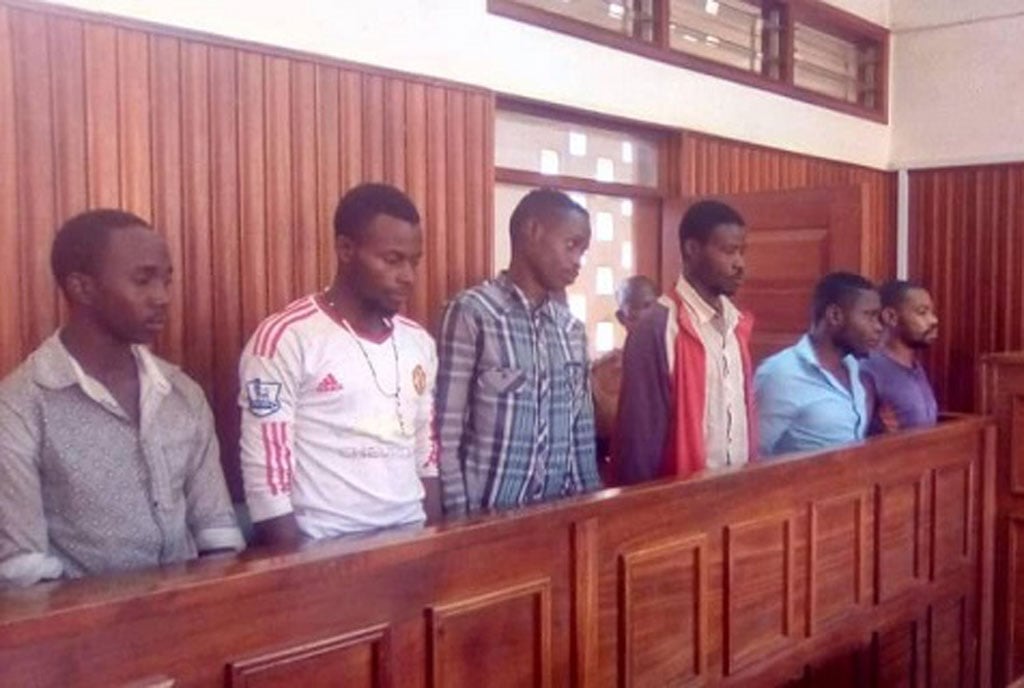Upcountry courts top in case backlog

Chief Justice Alfonse Owiny-Dollo signs the Judiciary performance report for 2021/2022 during its launch at High Court in Kampala on August 31, 2022. In the background is Attorney General Kiryowa Kiwanuka (left) and Minister of Justice and Constitutional Affairs Norbert Mao (centre). PHOTO | ABUBAKER LUBOWA
What you need to know:
- High Court circuits had 19,824 cases of backlog (59.6 percent) out of the 33,222 pending ones while Supreme Court had 335 (49.2 percent) cases out of 686.
Chief Justice Alfonse Owiny-Dollo used the launch of the Judiciary annual performance report of FY2021/2022 to name the courts with the highest case backlog.
High Court circuits (upcountry courts) and the Supreme Court topped the list. A case falls under backlog when it has been in the court system for more than two years without being determined.
Chief Justice Owiny-Dollo said if he is given the required number of judicial officers, he will demand a written apology from any officer who presides over a case for more than a year.
He said Shs7 trillion is stuck in the Commercial and Land divisions of the High Court due to lack of judges to hear cases.
The Chief Justice asked the Executive to give him at least 15 judges for each of the two divisions.
According to the annual Judiciary report released in Kampala yesterday, the total case backlog stood at 50,592 cases (30.11 percent) against 168,007 pending ones.
This was a 2.23 percent (1,156 cases) reduction from the FY2020/2021 status of 51,748 backlog cases against 161,054 pending ones.
High Court circuits had 19,824 cases of backlog (59.6 percent) out of the 33,222 pending ones while Supreme Court had 335 (49.2 percent) cases out of 686.
The Court of Appeal/ Constitutional Court and the Chief Magistrates Courts posted the lowest case backlog at 4,887 (11.3 percent) and 11,231 (15.7 percent), respectively. Grade one magistrate courts also posted a reduction in case backlog with 2,560 (11.3 percent) cases out of the 22,569 pending ones.
The Justice ministry tabled a Cabinet proposal to amend the Constitution to increase the numbers of judges across the board.
If passed, the Supreme Court justices will be increased from 11 to about 21, while the Court of Appeal will have 56 judges up from 15.
At the High Court level, the number of justices will increase from the current approved structure of 82 to 151.
Chief Justice Owiny-Dollo said in the past financial year, the Judiciary received additional 258 judicial officers to bridge the staffing gaps and improve service delivery.
“This recruitment increased the staffing levels of judicial officers from 37 percent in FY 2020/2021 to 45 percent in FY2021/2022,” he said.
Chief Justice Owiny-Dollo added that the Judiciary increased physical access to services through construction of courts.
“By December, the Supreme Court should have been completed so that the Judiciary gets its own home,” the Chief Justice said.
He added that construction of Mukono High Court, Kole and Namayingo justice centres are at completion stage.
“Mayuge Chief Magistrates Court, Buyende Magistrates Court, Sembabule Justice Centre, Butambala and Kamwenge mini justice centres are still under the defects liability period. Clearance was ongoing at the Magistrates Courts of Patongo, Alebtong and Karenga,” he said.
The Chief Justice also said following last year’s General Election, the Judiciary registered a total of 160 petitions at the parliamentary and Local Council chairpersons level.
Parliamentary petitions were 102, LC chairpersons level (49), and miscellaneous applications (nine).
Election petitions
Chief Justice Owiny-Dollo said the Court of Appeal had a total of 162 election petitions, nine were withdrawn, while 151 were heard and completed within six months.
“Among the appeals heard, five cases were sent for by-elections while eight for retrial. We are happy that this time all election matters were dealt with expeditiously,” he said.
Regarding cases disposed of, Chief Justice Owiny-Dollo said a total of 205,967 cases out of 373,974 were cleared, which accounted for 55 percent of all cases in the system.
He attributed the progress to automation of court processes, and increased use of the alternative dispute resolution mechanism.
The Chief Justice cited several challenges in the Judiciary, including weaknesses of key sister agencies and corruption, among others.




